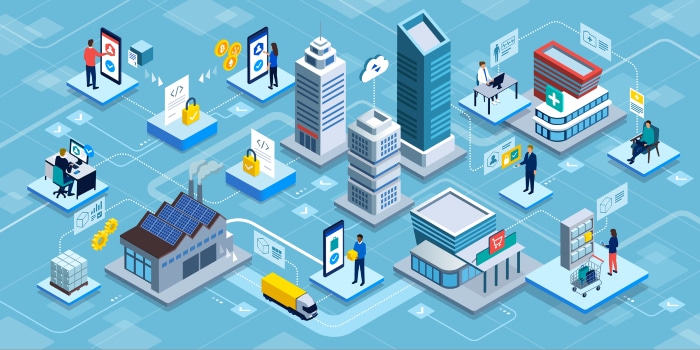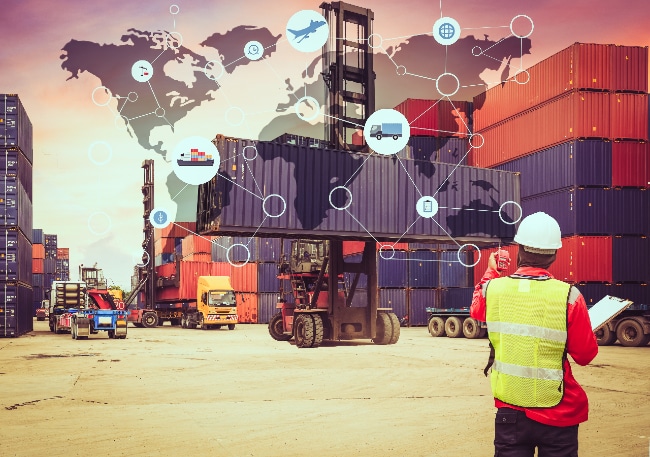This is an interview with André Simha, Global Chief Digital & Information Officer at MSC Mediterranean Shipping Company. André is also a key contributor to our Certificate in Digital Trade Strategy, a new online certification from ICC Academy developed in partnership with the ICC Digital Standards Initiative. Please note the views shared in this post do not necessarily reflect those of ICC Academy.
Why should an organisation make digitising their trade and supply chains a priority? What are the biggest potential benefits in your opinion and what are the costs, both financially and operationally, of not doing so?
André Simha (AS): At MSC, we believe digitalisation is the future of shipping, as it unlocks new levels of efficiency, transparency, predictability, security and sustainability. Digital is no longer a ‘nice to have’ add-on; it’s something the entire supply chain needs to embrace. So, it’s great to see that demand is growing from shippers and stakeholders alike. An overwhelming majority favour increased visibility and real-time information sharing in our industry.
We have gone from tracking containers manually by updating cards on the wall, to real-time container tracking 24 hours a day, anywhere in the world.
We have seen computers evolve from bulky notetaking machines to instant portals for connection and efficiency.
We have gone from physically posting or couriering bills of lading (BLs) across the world, to an electronic version (eBL) we can share online in just a few clicks.
In an industry such as shipping, tech should not be seen as a short-term differentiator.
It’s not like the consumer electronics sector, where the aim is to be innovative and quick to market. Instead, in shipping, we view technology as a long-term enabler.
Similarly, it’s not just about how information flows within an organisation but also how it flows throughout the entire supply chain ecosystem.

Digital transformation can’t happen in isolation, especially in our interconnected world and integrated supply chains. If we innovate on our own, we will all invest substantial amounts of money and resources and in the end, our customers will not reap the benefits of interoperability.
If we innovate together, we can share some of the costs and research and ensure we give our customers a solution that works.
What do you see as the key challenges and obstacles to trade and supply chain digitisation in the maritime industry?
AS: It might sound surprising, but one of the most common mistakes I’ve seen during my 35+-year career is focusing on the tech itself, rather than the end result.
To me, digital transformation is not simply about technology, but about making people better at what they do.
That’s why people need to be an integral part of any transformational project. That includes contributing their ideas.
The idea of embracing innovation can trigger feelings of fear, such as fear of change, fear of the unknown, fear of failure, fear of being criticised, etc. But there are many ways to overcome these concerns, as I explored in one of my recent blog posts on LinkedIn.
What impact would you like the new Certificate in Digital Trade Strategy (CDTS) to have? Why are you excited to be involved with this new online course?
AS: I am delighted to contribute to this curriculum, which will help learners gain a deep understanding of the components needed to digitise trade and supply chain processes at scale.
MSC is the only large carrier invited to feature as part of this course. It’s great recognition of the leading role MSC plays in the industry as the world's biggest container shipping line, and as a driving force behind the maritime industry’s digital transformation.
MSC fundamentally believes in making a concerted effort towards establishing industry standards. We are convinced that their adoption will propel the entire supply chain into a new era of connectivity, efficiency, security and sustainability.
So, whether you’re a policymaker working on electronic documentation, a carrier or shipper looking to enhance efficiencies, or a tech provider offering a cutting-edge logistics platform, we can all make an impact.
You can be part of this ongoing transformation. But you need to understand the complexity and interdependence of the ecosystem in which we exist. You must work with a digital mindset and have a holistic approach oriented towards interoperability – which the CDTS is designed to give you.
What impact has the Covid-19 pandemic had on the trend towards digitalisation? What are some of the key developments you think it has accelerated over the last 2-3 years?
AS: The COVID-19 pandemic has accelerated the trend towards digitalisation, showing the importance of rethinking processes and working together.
- One concrete example is the eBL (electronic bill of lading). This is because of the difficulties in moving trade documents due to the lack of flights. So, we have seen extreme interest in China and India, and interest in Southeast Asia is also picking up fast. Other players such as banks and customs are also attracted by the proposition and see it as a good idea.
- Outside eBL, and generally speaking, there is a growing interest from national governments, international bodies, regulators and trade facilitators to make ports and shipping more efficient.
- Embracing digital through collaborations and pilot projects: I see more and more collaboration between the traditional stakeholders of the maritime industry. Examples include TradeLens or GBSN, DCSA Just-in-Time Port Call Optimisation proof-of-concept, Singapore-Rotterdam’s digital corridors, the Future International Trade (FIT) Alliance, the US FLOW initiative, etc.
- Interoperability is key. I see increased adoption of DCSA* standards, as well as recognition from other industry associations and governmental initiatives.
* DCSA is a neutral, non-profit group established by several of the largest container shipping companies to further the digitalisation of container shipping through technology standards. Find out more at https://dcsa.org/
What does the term interoperability mean in the digitisation of trade? Please feel free to give an example of what this looks like or might look like.

AS: The shipping industry is interconnected. Like a relay race, we pass the baton from one to another as we move cargo across the world.
Carriers, ports, terminals and freight forwarders work together to move cargo from A to B. Each link is important, and each link is connected.
As a result, gains in one area can be undermined by another.
Indeed, there’s little point in cutting transit time at sea if a vessel ends up stuck outside the port.
Standards define how we talk to each other. They provide a common data language and process framework. In other words, they determine how we pass the baton to each other.
The better the standards, the smoother the communications and transitions. In a big and complex industry like shipping, only standards can create the solid foundations we need to enable interoperable IT solutions and widespread adoption of digital technologies.
To give a concrete example, the Just-in-Time (JIT) Port Call standards play a key role in exchanging event data in a uniform way between carriers, ports and terminals. By using these standards, vessels can better adjust travel speed to arrive just in time, reducing fuel use and carbon emissions during the journey.
This has a positive effect on the customer experience, with more predictable cargo operations at ports and terminals.
And by the way, the very fact you understand this article is because we are writing in standard...English!
What trend or development in supply chain digitisation are you most excited about seeing accelerate in the next 3-5 years?
AS: Here are some of the significant developments I see for the coming year.
- Paperless trade: The eBL has been the first major step toward digitising documents, but this year I anticipate more and more important documents being digitised (opening data-sharing opportunities in the process).
- Internet of Things (IoT) enabled real-time tracking and remote monitoring: We are going through an evolution right now. Containers are starting to represent more than just a metal box on a ship or truck, or at the port. They are becoming increasingly digitalised, and these so-called “Smart Containers” can solve some of the biggest pain points for our customers
- Online self-service: Customers are increasingly interested in engaging through digital platforms. Innovative technologies can improve customer service and experience while preserving customer-centricity and a personal touch. They are not incompatible/contradictory.
- Data quality and analytics for quicker and wiser decision-making: Today’s digital world is all about data. And data in the 21st century is a bit like oil in the 18th century. It’s an incredibly underutilised and valuable asset, but it needs to be refined before it can really be used.
In other words, we don’t just need data; we need good data. And as the volume of data increases, so does the importance of standards for interoperability.
Lastly, quality must win over quantity. By investing in data analytics, companies can make better decisions.
- People: How do we ensure the right mix of employees and create an environment in which everyone can get the best outcomes? That’s a key requirement if we want to attract, retain and motivate the right people to shape the industry’s future.
A greater emphasis on training is definitely needed. And our industry needs a more diverse mix of people from diverse backgrounds, bringing different perspectives. Better equity and inclusion = better outcomes.

